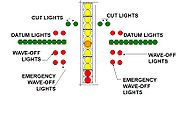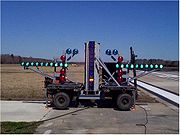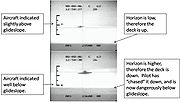
Optical Landing System
Encyclopedia

Aircraft carrier
An aircraft carrier is a warship designed with a primary mission of deploying and recovering aircraft, acting as a seagoing airbase. Aircraft carriers thus allow a naval force to project air power worldwide without having to depend on local bases for staging aircraft operations...
. From the beginning of aircraft landing on ships in the 1920s to the introduction of OLSs, pilots relied solely on their visual perception of the landing area and the aid of the Landing Signal Officer
Landing signal officer
Landing Signal Officers are naval aviators specially trained to facilitate the "safe and expeditious recovery" of naval aircraft aboard aircraft carriers. Originally LSOs were responsible for bringing aircraft aboard ship using hand signals...
(LSO in the US Navy, or "batsman" in the Commonwealth navies). LSOs used colored flags, cloth paddles and lighted wands.
Components

Lights
At least three sets of lights, regardless of the actual technology are used:- Datum lights — a horizontal row of green lamps used to give the pilot a reference against which he may judge his position relative to the glide slope.
- Ball (or “meatball”; also known as "the source") — indicates the relative position of the aircraft with reference to glide slope. If the aircraft is high, the ball will be above the datum lights; if the aircraft is low, the ball will be similarly below the datums. The further the aircraft is from the glide slope, the further the ball will be above or below the datum lights. If the aircraft gets dangerously low, the ball appears red. If the aircraft gets too high, the ball appears to go off the top.
- Wave-off lights — red flashing lamps which, when lit, indicate that the pilot must add full power and go around — a mandatory command. When the wave-off lights are lit, all other lamps are extinguished. The wave-off lights are operated manually by the LSO.
Additionally, some (particularly later) optical landing systems include additional lamps:
- Cut lights — Green lamps used to signal different things based on where the approaching aircraft is in its approach. Early in a no-radio or "zip-lip" approach (which is routine in modern carrier operations), Cut Lights are flashed for approximately 2–3 seconds to indicate that the aircraft is cleared to continue the approach. Subsequent flashes of the Cut Lights are used to prompt the pilot to add power. The longer the lights are left on, the more power should be added. Cut Lights are operated manually by the LSO.
- Emergency wave-off lights - Red lamps that have the identical function as Wave-Off Lights, but use an alternate power source. Not normally used.
Light controls
Collectively, the apparatus that the lights are mounted on is called “the lens”. It is turned on/off and brightness is adjusted at the lens itself for ground based units, and remotely for shipboard units. In both cases, the lens is connected to a hand-controller (called the “pickle”) used by the LSOs. The pickle has buttons that control the wave-off and cut lights.Light mounting
For shore-based Optical Landing Systems, the lights are typically mounted on a mobile unit that plugs into a power source. Once set up and calibrated, there are no moving parts to the unit. Shipboard units are much more complicated as they must be gyroscopically stabilized to compensate for ship movement. Additionally, shipboard units are mechanically moved (the “roll angle”) to adjust the touchdown point of each aircraft. With this adjustment, the tailhook touchdown point can be precisely targeted based on the tailhook-to-pilot’s eye distance for each aircraft type.Mirror landing aid
The first OLS was the mirror landing aid, one of several British inventions made after the Second World War revolutionising the design of aircraft carriers. The others were the steam catapult and the angled flight deck. The Mirror Landing Aid was invented by Nicholas GoodhartNicholas Goodhart
Rear Admiral Hilary Charles Nicholas 'Nick' Goodhart CB Legion of Merit FRAeS RN rtd was an engineer and aviator who invented the mirror-sight deck landing system for aircraft carriers. He was also a world champion and record breaker in gliding.-Early life:He was born at Inkpen, Berkshire, the son...
. It was tested on the carriers HMS Illustrious and HMS Indomitable before being introduced on British carriers in 1954 and on US carriers in 1955.
The mirror landing aid was a gyroscopically-controlled concave mirror on the port side of the flight deck
Flight deck
The flight deck of an aircraft carrier is the surface from which its aircraft take off and land, essentially a miniature airfield at sea. On smaller naval ships which do not have aviation as a primary mission, the landing area for helicopters and other VTOL aircraft is also referred to as the...
. On either side of the mirror was a line of green coloured "datum lights". A bright orange "source" light was shone into the mirror creating the "ball" (or "meatball" in later USN parlance) which could be seen by the aviator who was about to land. The position of the ball compared to the datum lights indicated the aircraft's position in relation to the desired glidepath: if the ball was above the datum, the plane was high; below the datum, the plane was low; between the datum, the plane was on glidepath. The gyro stabilisation compensated for much of the movement of the flight deck due to the sea, giving a constant glidepath.
Initially, the device was thought able to allow the pilot to land without direction from the LSO. However, accident rates actually increased upon the system's initial introduction, so the current system of including the LSO was developed. This development, along with the others mentioned, contributed to the US carrier landing accident rate plummeting from 35 per 10,000 landings in 1954 to 7 per 10,000 landings in 1957.
The LSO, who is a specially qualified and experienced Navy pilot, provides additional input to the pilot via radios, advising of power requirements, position relative to glide path and centerline. The LSO can also use a combination of lights attached to the OLS to indicate "go around" using the bright red, flashing wave off lights. Additional signals, such as "cleared to land," "add power," or "divert" can be signaled using with a row of green "cut" lights or a combination thereof.
Fresnel lens optical landing system (FLOLS)
Later systems kept the same basic function of the mirror landing aid, but upgraded components and functionality. The concave mirror, source light combination was replaced with a series of fresnel lensFresnel lens
A Fresnel lens is a type of lens originally developed by French physicist Augustin-Jean Fresnel for lighthouses.The design allows the construction of lenses of large aperture and short focal length without the mass and volume of material that would be required by a lens of conventional design...
es. The Mk 6 Mod 3 FLOLS was tested in 1970 and had not changed much, except for when ship’s heave was taken into account with an Inertial Stabilization system. These systems are still in wide use on runways at US Naval Air Stations.
Improved fresnel lens optical landing system (IFLOLS)

USS George Washington (CVN-73)
USS George Washington is an American nuclear-powered supercarrier, the sixth ship in the Nimitz class and the fourth United States Navy ship to be named after George Washington, the first President of the United States...
in 1997 and every deploying aircraft carrier since 2004 has had the system. The Improved Fresnel Lens Optical Landing System, IFLOLS, uses a fiber optic "source" light, projected through lenses to present a sharper, crisper light. This has enabled pilots to begin to fly "the ball" further away from the ship making the transition from instrument flight to visual flight smoother. Additional improvements include better deck motion compensation due to internalization of the mechanism.

Manually Operated Visual Landing Aid System (MOVLAS)

There are three installation modes aboard ship: STATION 1 is immediately in front of the FLOLS and utilizes the FLOLS waveoff, datum, and cut light displays. STATION 2 and 3 are independent of the FLOLS and are located on the flight deck port and starboard side respectively. MOVLAS is nothing more than a vertical series of orange lamps manually controlled by the LSO with a hand controller to simulate the ball.
MOVLAS components
Lightbox- MOVLAS is nothing more than a vertical series of orange lamps manually controlled by the LSO with a hand controller to simulate the ball.
Hand Controller
- The hand controller is located at the LSO workstation. A handle is provided so the LSO may select the position of the meatball. The pickle switch is attached to the end of the controller handle. As the handle on the LSO controller is moved up or down it lights three or four consecutive lamps in the light box thus providing a meatball.
Repeaters
- MOVLAS repeaters show where the LSO is displaying the meatball to the pilot. One repeater is displayed on the Integrated Launch And Recovery Television Surveillance SystemIntegrated Launch And Recovery Television Surveillance SystemThe Integrated Launch and Recovery Television Surveillance System provides the Landing Signal Officer with a reference for aircraft lineup and glideslope information during recovery operations aboard US aircraft carriers, and is used as a debriefing medium for pilots...
(ILARTS).
Pitching deck

See also
- Flight deckFlight deckThe flight deck of an aircraft carrier is the surface from which its aircraft take off and land, essentially a miniature airfield at sea. On smaller naval ships which do not have aviation as a primary mission, the landing area for helicopters and other VTOL aircraft is also referred to as the...
- Modern US Navy carrier air operationsModern US Navy carrier air operationsModern United States Navy aircraft carrier air operations include the operation of fixed wing and rotary aircraft on and around an aircraft carrier for performance of combat or non-combat missions. Modern United States Navy aircraft carrier flight operations are highly evolved, based on experiences...
- Visual approach slope indicatorVisual Approach Slope IndicatorThe visual approach slope indicator is a system of lights on the side of an airport runway threshold that provides visual descent guidance information during the approach to a runway...
External links
- http://www.flightglobal.com/pdfarchive/view/1954/1954%20-%200734.html'New Approach to Carriers' - a brief article on the Royal Navy's new angle-of-approach indicator in a 1954 edition of FlightFlight InternationalFlight International is a global aerospace weekly publication produced in the UK. Founded in 1909, it is the world's oldest continuously published aviation news magazine...
]

